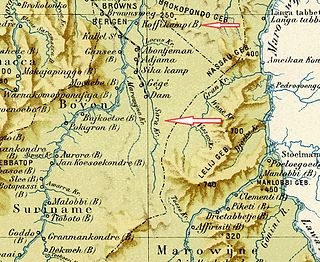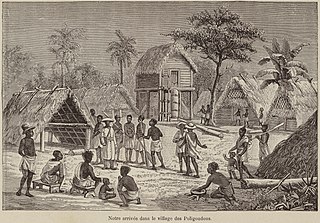De West is one of the main newspapers of Suriname.

Flora is a resort in Suriname, located in the Paramaribo District. Its population at the 2012 census was 19,538. Flora is both the name of the resort and the neighbourhood within the resort. Flora was founded as a wood plantation in 1809.
Sabakoe is an Amerindian hamlet in Para District, Suriname, located near Zanderij. It is also the Surinamese name of little blue herons, which is used as the logo of Surinam Airways.

André R.M. Pakosie is a Surinamese historian, poet, Ndyuka activist and Edebukuman of the Afaka script.
Reinier Soejatno Asmoredjo is a Surinamese artist of Javanese descent. Asmoredjo received his training at the Academy of Art and Culture Higher Education (AHKCO) in Paramaribo, and graduated in 1989 with a Bachelor of Arts. From 1995 he was a teacher in drawing on the General Secondary School (AMS) and since 2001 he has been an instructor at the Academy of Art and Culture. Since 1999 he has been a member of the Association of Visual Artists in Suriname (FVAS), and since 2001 has been a member of the Association of Fine Art in Suriname (ABKS). In 2013 he showcased his work at the National Art Fair in Paramaribo.

Surendre Sradhanand "Soerinder" Rambocus was a Surinamese serviceman. For a short period, he was the highest ranking officer of the Suriname National Army. He was involved in the unsuccessful coup d'état of March 1982 against the then dictator of Suriname, Dési Bouterse, and was executed on 8 December 1982 as one of the December murders.

MariaLobach Hartmann was a German-born Moravian missionary in Suriname.

Paramacca is a resort in Suriname, located in the Sipaliwini District. The population is estimated between 1,500 and 2,000 people. In 1983, the Sipaliwini District was created, and the eastern part became the resort of Tapanahony. The Paramacca resort is the northern part of Tapanahony, and mainly inhabited by the Paramaccan people, the border of the resorts is the island of Bofoo Tabiki in the Marowijne River.
Bernharddorp is an indigenous village of Lokono and Kalina Amerindians in the resort of Noord in the Para District in Suriname.
Witsanti is an indigenous village of Lokono and Kalina Amerindians in the resort of Zuid in the Para District in Suriname. The village is located on the John F. Kennedyweg near the Johan Adolf Pengel International Airport.

Uitkijk is a village in the resort of Kampong Baroe in the Saramacca District of Suriname. The village is located on the Saramacca River.

Powakka is an indigenous village of Lokono Amerindians in the resort of Oost in the Para District in Suriname. The village is located on the road to Carolina which connects to the Afobakaweg to Paramaribo.

Manlobi is a village of Ndyuka Maroons in the Sipaliwini District of Suriname. The village is located on an island in the Tapanahony River.
Wim Bos Verschuur, born Bernard Willem Hendrik Verschuur was a Surinamese politician, activist, artist, and writer. On 30 July 1943, he was arrested and interned for opposing governor Johannes Kielstra; this caused a major scandal in Surinam politics and led to a larger wave of repression against opposition figures.

Marylin Simons is a Surinamese writer and columnist. She is best known for In naam van God en Obia (2002) for which she was awarded the Kwaku Literature Prize, and her youth book Carrousel (2003).

Sara Creek is a former tributary of the Suriname River located in the Para District of Suriname. After the completion of the Afobaka Dam in 1964, the Sara Creek flows into the Brokopondo Reservoir. In 1876, gold was discovered along the Sara Creek, and a railway line from Paramaribo to the river was completed in 1911.

Percy Wijngaarde was a Surinamese journalist, politician of the NPS and diplomat.

Berlijn is a village and former wood plantation in the resort of Zuid in the Para District in Suriname. It is located on the Para Creek, and about 4 kilometres (2.5 mi) from the Johan Adolf Pengel International Airport.

Dirk Cornelis Geijskes was a Dutch biologist, ethnologist and curator. He was the first director of the Surinaams Museum. As a biologist, he specialised in dragonflies. He would lead many expeditions into the interior of Suriname. In 1967, he became curator at the Rijksmuseum van Natuurlijke Historie where he started the dragonfly collection. Geijskes is the author of 123 publications, and 25 species have been named after him.

Poeloegoedoe is a village in the Tapanahony River at the confluence with the Lawa River. It is named after the Poeloegoedoe Falls and is inhabitated by maroons of the Ndyuka people. The village is located in the Tapanahony resort of Sipaliwini District, Suriname.














